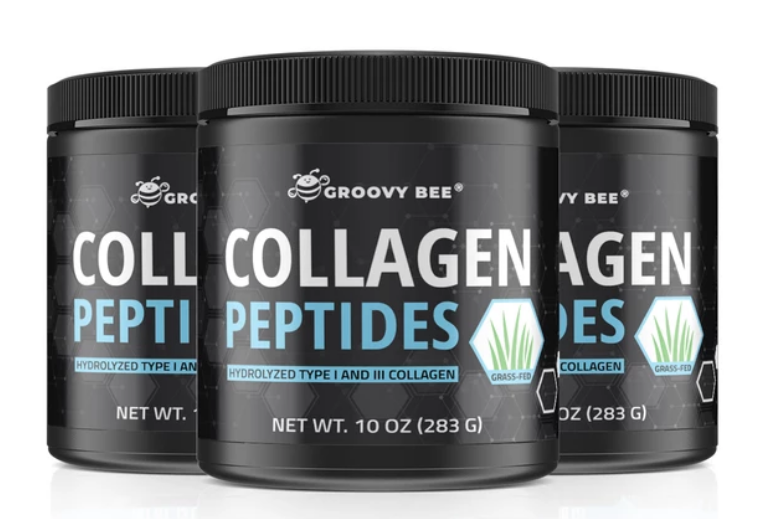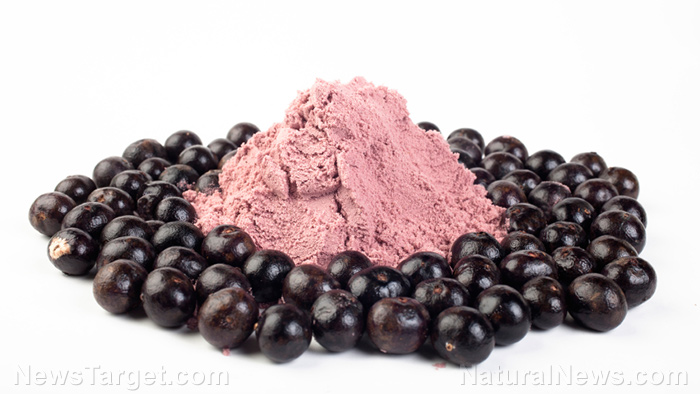We’ve completed the lab testing: “Groovy Bee” Collagen Peptides (hydrolyzed collagen) now available through the Health Ranger Store
10/17/2019 / By Mike Adams

For the last three years, we’ve had many requests for a collagen peptides product, but given that collagen peptides are animal-derived, this product category requires extra scrutiny using high-end laboratory analysis equipment.
Because most animals are fed GMO feed that’s laced with glyphosate, the cancer-causing herbicide chemical used across modern agriculture, it is a legitimate concern that glyphosate could find its way into animal-derived products such as meats or even collagen peptides.
This concern is further underscored by the fact that glyphosate is:
1) A very small molecule (169 daltons, which is tiny for an herbicide or pesticide), allowing it to easily pass through cell membranes.
2) A “polar” water soluble molecule, meaning it has the right polarity (chemical electrical properties) to easily go into solution with water, which is abundant in the body.
3) It is a known chelator that can easily bind with certain minerals that may be present in animal and human physiology, thus being transported to tissues in the body where minerals are transported.
Could glyphosate find its way into collagen peptides?
For these reasons, we have long been concerned that collagen peptide products might be contaminated with glyphosate and AMPA, a glyphosate derivative molecule that’s often found alongside glyphosate itself.
But testing for glyphosate is extremely complex and costly. At CWC Labs, we spent over two years perfecting and validating a tandem mass-spec method for glyphosate quantitation. The chemistry of glyphosate is truly bizarre, requiring multi-mode chromatography columns that reverse the rules of “reverse-phase chromatography.” (In other words, water is the strong solvent, not methanol.) Furthermore, the ionization of glyphosate molecules present enormous chemistry challenges which are highly susceptible to pH changes. It turns out that the glyphosate molecule morphs into at least four different molecular formats as pH levels change, and each molecular format reacts differently with the multi-mode chomatography columns.
Truly, glyphosate is the “chameleon” of toxic herbicides. It exists as a kind of stealth molecule that has strongly resisted analytical quantitation for decades.
But after years of research and method development, we’ve mastered both the analytical quantitation of glyphosate and the complex sample prep techniques required to achieve significant analyte recoveries from food samples being tested. Simply put, this means we can now accurately detect glyphosate / AMPA levels in collagen peptide products, even down to sub-ppb concentrations.
We actually released a video tour of our laboratory, in case you’re curious to see all the instruments and testing protocols we follow:
The quest to find clean collagen
With this analytical infrastructure in place, we’ve been testing all our own products as well as other brands, always on the look out for clean sources of microalgae, superfoods and even collagen, which has become a very popular supplement among health-conscious consumers.
Using this technology, we’ve been able to confirm the cleanliness and purity of Groovy Bee Collagen Peptides, which we now carry at the Health Ranger Store. GroovyBee.com also sells this product at their own store. The entire Groovy Bee brand is using our laboratory services to authenticate product safety and purity.
Why collagen? People really like to add collagen to their smoothies and even coffee recipes. Since we all lose natural collagen production as we age, there seems to be increased interest in this product among those who are over 40. With so many popular brands on the market, it’s difficult to know which brands are truly clean and tested. So let me share what I know as a published scientist and experienced expert in analytical science and food testing. Here it is:
Almost nobody tests their products. (With very few exceptions.)
It just isn’t done as a routine thing. Nearly all manufacturers rely on “certificates of analysis” which are scanned reports that claim a raw material meets certain standards carried out by some other lab and some date in the past. But here’s the dirty little secret about that: Most “standards” allow for crazy high levels of contaminants, including heavy metals, glyphosate, yeast and mold, etc.
For example, in our world, an A+++ rating on glyphosate means anything less than 10 ppb (parts per billion). But the FDA allows 10,000 higher levels of glyphosate in most U.S. foods. (See GlyphosateTested.com for the full ratings chart.)
In our lab testing, we’ve seen crazy high levels of glyphosate in off-the-shelf breakfast cereals, breads, oatmeal products, gluten-free products, legumes and much more. (Some new lab videos will be coming out this year with more details of our findings.)
The Groovy Bee Collagen Peptides are A+++ rated from our lab, meaning we found less than 10 ppb glyphosate and AMPA combined. As the instrument analyst who actually ran these tests, I can tell you the amount of glyphosate in this product is actually zero, at least to the sensitivity of this instrument, which is capable of detecting glyphosate at 0.39 ppb (which is 390 parts per trillion).
European Union standards — which are the strictest glyphosate standards in the world — approve most foods as “safe” if they contain less than 100 ppb glyphosate. For some foods, like certain legumes, the EU allows up to 30,000 ppb (which I find truly astonishing).
The dirty truth about food labs and police labs: False negatives vs. false positives
In summary, we have subjected this Groovy Bee collagen to more laboratory scrutiny than, I believe, any collagen product in the world. It has come to my attention that we conduct more tests than most raw materials producers themselves, and we run those tests with extreme sensitivity and instrument tuning that’s designed to produce very high signal-to-noise data sets, even from very tiny amounts of contaminants.
Thanks to all that, for the first time, I am now adding this Groovy Bee collagen to my smoothies. Previously, I refused to do so because I simply didn’t trust other brands. And since we didn’t have the glyphosate testing nailed until this year, we had no way to know whether the collagen products really contained glyphosate.
When it comes to animal products, I won’t eat something unless it’s laboratory verified. And since I work in the lab industry, I’ve come to learn another unfortunate, dirty truth about lab science in the food industry: A lot of the science is faked to produce a “false negative” result. This is accomplished, by the way, by de-tuning analytical instruments to make them significantly less sensitive than they could be. By reducing the sensitivity of any given instrument, an unethical lab can claim “not detected” for almost anything, at any level.
Lab instruments can be de-tuned in many ways to achieve this subterfuge. While law enforcement labs are often used to produce false positives in order to falsely convict innocent people of drug possession — yes, the most untrustworthy labs in the world are law enforcement labs — many food industry labs specialize in producing “false negatives,” meaning they produce a “not detected” result for almost anything.
On mass spec instruments, this can be accomplished in a variety of ways that are unethical and deceptive:
1) Positioning the ion stream off-axis in order to greatly reduce the quantity of ionized molecules entering the instrument through the sample introduction cone or skimmer.
2) Using high background solvents that add “noise” to the analytical results, effectively blinding the signal with noise.
3) Using partially evaporated standards which have artificially high concentrations of target analytes, causing all the real food samples to appear artificially low in comparison.
4) Deliberately using poor solvent extraction techniques in sample prep, resulting in extremely poor analyte recoveries which are never adjusted for recovery rates that should apply to that specific food matrix. For example, some pesticides are extracted with methanol, others with water, and others need acetonitrile or even hexane. Deliberately using the wrong solvent can foods appear to be completely free from certain pesticides for the simple reason that using the wrong solvent will never extract those molecules in the first place.
5) Artificially increasing method flow rates to shift retention times of targeted analytes, causing them to “peak” outside the time window associated with the analyte standards. Higher flow rates also reduce ionization efficiency, effectively “hiding” targeted chemicals.
… and so on. If I thought about it more, I could probably think of a dozen more ways to screw up the science on this, given that you have to do about a hundred things absolutely correctly in order to get good results.
Coming soon: Publicly available test kits for glyphosate / AMPA testing
Shortly, by the way, we will announce public glyphosate testing services at CWClabs.com. We are also announcing a new glyphosate testing standard at GlyphosateTested.com, which is already live if you want to take a peek. You will soon begin to see these Glyphosate Tested certifications on all our products across HealthRangerStore.com, which is where we offer lab-tested foods, superfoods and personal care products that have been subjected to extensive laboratory analysis to ensure their safety and purity.
There’s much more coming on this subject. In the mean time, if you’re into collagen peptides, we finally have a product we trust enough to carry (and consume) ourselves: Groovy Bee Collagen Peptides.
Eat safe!
Tagged Under:
RECENT NEWS & ARTICLES
COPYRIGHT © 2017 SUPERFOOD NEWS



















